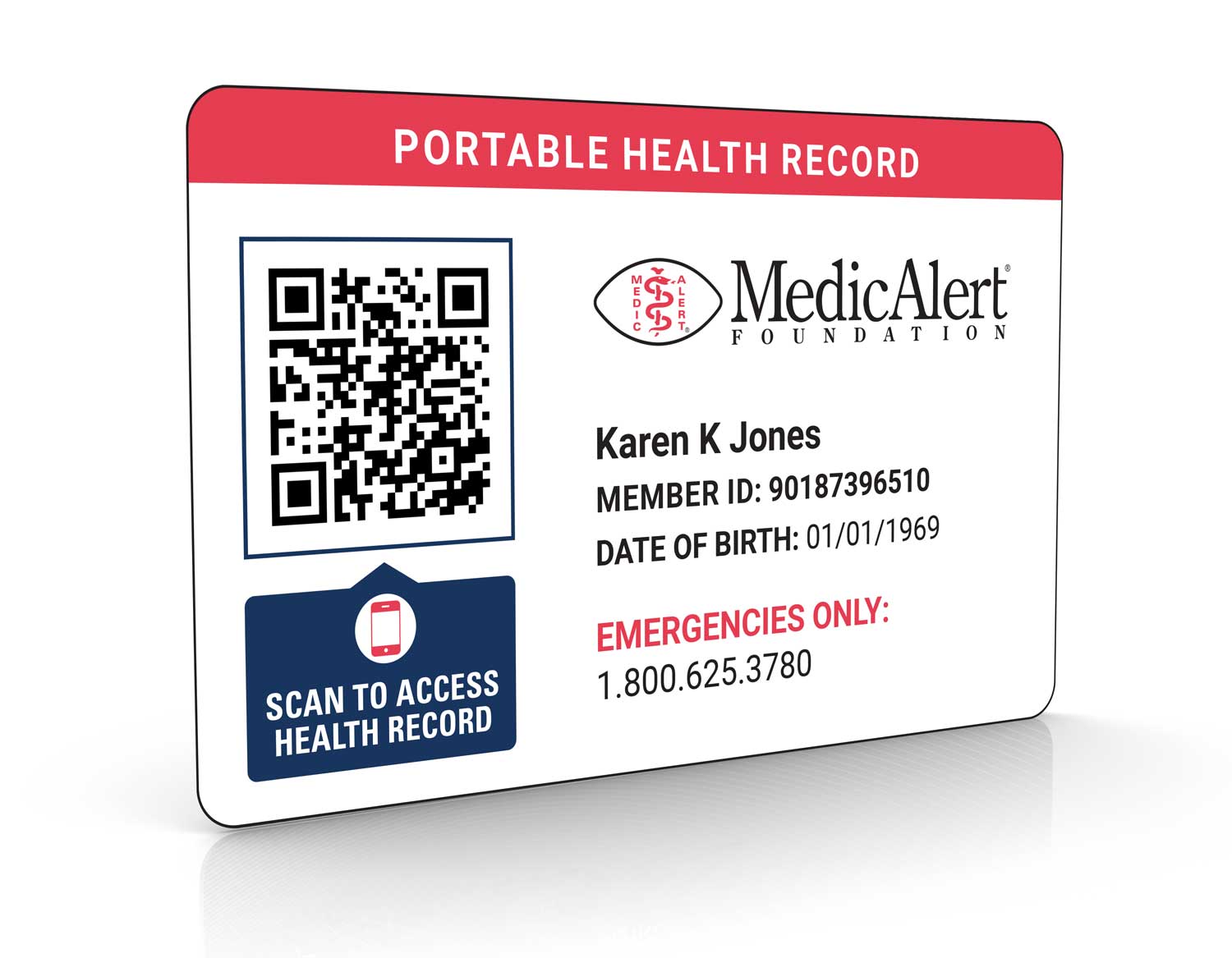Help others help you. Wear a medical alert ID bracelet or necklace engraved with important information for emergency responders and healthcare providers.
Centers for Disease Control & Prevention

Medical IDs for POTS
The confidence to live with postural orthostatic tachycardia syndrome (POTS)
Postural orthostatic tachycardia syndrome (POTS) is a disorder that causes a dramatic increase in the heart rate. While it is normal for the heart rate to increase during exercise or stress, POTS causes unusual jumps in the heart’s beating pattern when a person sits up or stands up from a reclining position. This dramatic jump leads to blood pressure fluctuations, which can cause symptoms ranging from fatigue to fainting.
Although POTS affects millions of people around the world, there is no cure for the condition. Fortunately, POTS can be managed with medication, rehabilitation, and other interventions. People living with POTS can also take a number of steps on their own to protect themselves.
One of the most important steps is to wear a MedicAlert medical ID for POTS.
How MedicAlert protects those living with POTS
One thing you shouldn’t worry about is what could happen if there’s an emergency. MedicAlert’s protection plans offer benefits that extend beyond the ID, providing safety and peace of mind for people living with POTS, their families and caregivers.

24/7 Emergency Response
Our team provides first responders the information they need to provide fast, accurate care.

Digital Health Profile
All your vital information, all in one place for you and your caregiver.

Emergency Contact Notification
In an emergency, we connect families so that no one is alone in a crisis.

Patient Instructions
Share the information that’s important to your care, such as use of rescue medications or contraindication for tests like MRIs.
Pair a medical ID for POTS with the protection plan that’s right for you.
What exactly is postural orthostatic tachycardia syndrome (POTS)?
POTS is a blood circulation disorder characterized by a few clear factors: an abnormal increase in heart rate that occurs after sitting up or standing. In a person living with POTS, the blood stays in the lower body when they stand up, causing the heart rate to jump dramatically. The heart rate can go up by as much as 30 beats per minute, resulting in head-to-toe symptoms that can affect an individual’s safety, confidence, and quality of life.
Between one and three million people in the U.S. are living with POTS. Although men and young children can develop POTS, an estimated 80% to 85% of people living with POTS are females between 15 and 50 years old. Researchers do not fully understand why POTS affects women more than men.
What causes postural orthostatic tachycardia syndrome (POTS)?
POTS has many possible causes that vary from person to person. Some common causes include viral illness, traumatic injury to the brain or other parts of the body, serious infections, or during and after pregnancy.
Other potential causes of POTS include chronic fatigue syndrome; underlying conditions such as diabetes, Lyme disease, lupus, hepatitis C, mononucleosis (mono), anemia, multiple sclerosis (MS), or cancer; alcohol or metal poisoning; and a muscle and joint condition known as Ehlers-Danlos syndrome.
Some people living with POTS were found to have a defective (inherited) gene that causes the overproduction of noradrenaline.
Anxiety and POTS
Because anxiety and POTS symptoms may overlap, people living with POTS are often misdiagnosed. Anxiety and POTS are two entirely different disorders. POTS is a physical disorder in which symptoms are triggered when a person sits up or stands from a reclining position. Anxiety is a mental health condition resulting from constant and overwhelming feelings of worry, dread, and fear. The intensity of these feelings can cause symptoms similar to POTS symptoms such as increased heart rate, sweating, and nervousness.
What are the symptoms and complications of postural orthostatic tachycardia syndrome (POTS)?
POTS symptoms can vary from mild to severe. Severe symptoms can interfere with everyday activities such as eating, walking, bathing, doing housework, standing, sitting upright, going to school, and working. Symptoms can occur almost immediately after sitting up or standing, or it could take up to 10 minutes for symptoms to appear.
While the symptoms below are usually mild, in around 25% of people living with POTS, they can be severe enough to interfere with routine activities.
- Belly pain or bloating
- Body aches or neck pain
- Constipation or diarrhea
- Excessive sweating
- Feeling anxious
- Feeling hot or cold
- Headaches
- Inability to exercise
- Insomnia
- Nausea and vomiting
- Shaking or tremors
Severe POTS symptoms include:
- Blurry vision
- Chest pain
- Dizziness
- Extreme and/or long-lasting fatigue
- Higher or lower blood pressure
- Lightheadedness when sitting up or standing for long periods
- Pale face and purple discoloration of the hands and feet
- Pounding heart or heart palpitations (rapid or fluttering heartbeat)
- Slower heartbeat
- Temporary loss of consciousness (syncope or fainting)
- Trouble focusing, paying attention, or remembering things
- Worsening of general symptoms after increased activity
The most common POTS-related complication is fainting. It is also the most dangerous. When a person faints, they can fall. This can lead to fractures, blood loss from major cuts and gashes, and traumatic brain injuries (TBI) such as concussions, hemorrhages, and hematomas. Medical IDs for POTS can play an especially important role for those who may be unconscious when medical help arrives.
What to engrave on MedicAlert medical IDs for POTS:
MedicAlert offers free custom engraving on all our POTS bracelets and medical ID products. Engravings on medical IDs for POTS should include any critical medical information that can protect and save lives in an accident or medical emergency, for example:
- Postural orthostatic tachycardia syndrome (POTS)
- Medications
- Designated physician and emergency contact information
- Any additional critical medical information that needs to be communicated to first responders

Sample engraving. Consult our team if you need help engraving your medical ID for POTS.
How do you diagnose postural orthostatic tachycardia syndrome (POTS)?
The gold standard of POTS diagnosis is the tilt table test, which measures the heart rate and blood pressure when a person changes posture and position. Other diagnostic tests for POTS include:
- Autonomic breathing test to measure blood flow and blood pressure response during exercise.
- Blood tests that check the liver, thyroid gland, and kidneys to help rule out other causes.
- Echocardiogram (echo), which shows how well the heart muscle and valves are functioning.
- Electrocardiogram (EKG), which provides a clear picture of the electrical activity of the heart and how the heart is working.
- Hemodynamic test, which uses nuclear imaging to see how well the heart is working.
- Quantitative sudomotor axon reflex test (QSART), which measures the autonomic nerves that regulate sweating.
- Skin nerve biopsy, which helps doctors examine the nerves in the skin.
- Urine tests to measure sodium levels. These tests also help rule out other conditions.
To help diagnose POTS, doctors will also assess the individual’s family history and perform a physical exam.
How do you treat, manage, and live with postural orthostatic tachycardia syndrome (POTS)?
There is no cure for POTS. However, with proper treatment and guidance, studies suggest that an estimated 80% to 90% of individuals living with POTS can control their symptoms. In some cases, particularly in men, symptoms can disappear completely over several years.
Because symptoms and underlying conditions vary greatly, treatment plans for POTS are highly individualized and may include:
- Consistent exercise for 30 minutes at least four times a week, including lower limb and core resistance training, walking, swimming, recumbent biking, rowing, and Pilates.
- Medications such as beta blockers, salt tablets, fludrocortisone, midodrine, and pyridostigmine.
- Physical therapy, such as cardiac rehab, to recondition and help improve health. Cardiac rehab offers some of the best results.
- Self-care and lifestyle changes including adding more salt to the diet (if you do not have high blood pressure), avoiding alcohol and caffeine, drinking plenty of water, avoiding excessive heat, wearing compression garments, elevating the head of your bed, avoiding prolonged sitting, and rising slowly after lying down or sitting for a while before standing.
Help with navigating the daily balancing act of caregiving.
How medical IDs for POTS combined with MedicAlert Membership provide peace of mind
If you have a medical condition such as POTS, doctors and healthcare organizations recommend wearing a medical ID. Wearing a MedicAlert medical ID for POTS can help protect you in an emergency situation. MedicAlert IDs for POTS let emergency responders, doctors, and hospital staff know that you are living with the disorder, so certain steps can be taken to keep you safe.
When paired with a MedicAlert protection plan, our medical IDs become even more valuable to your safety and care. POTS can easily be mistaken for anxiety, a panic attack, or chronic fatigue syndrome. A medical ID for POTS combined with a MedicAlert protection plan can help first responders and ER doctors avoid this mistake. Our protection plan can ensure accurate and fast care by providing your full health profile to ER doctors, details about your medications and treatment plan, emergency contact information, designated physician’s information, and other information important to your care.
- We’re your voice: If you can’t speak for yourself due to a medical emergency, your ID will speak for you – informing others about your POTS and any medications you’re taking.
- 24/7 emergency protection: In an emergency, the MedicAlert team will relay all of your critical medical information to first responders, no matter where or when your emergency happens.
- Always connected: You should never be alone in an emergency. That’s why MedicAlert will reach out to your designated contacts if you are unable to do so.
- Live with peace of mind and confidence: MedicAlert will be there for you every step of the way. You’ll have the confidence and freedom to live your life with POTS, knowing we’ve got you covered.
DISCLAIMER: THIS WEBSITE DOES NOT PROVIDE MEDICAL ADVICE. The information in this article is presented for educational purposes only and is not intended as a substitute for professional medical advice, diagnosis and treatment. Always seek the advice of a physician or other qualified healthcare provider for any questions you may have regarding a medical condition or treatment.










